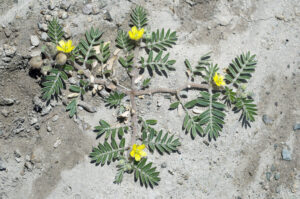Kaj Halberg - writer & photographer
Travels ‐ Landscapes ‐ Wildlife ‐ People
Burs

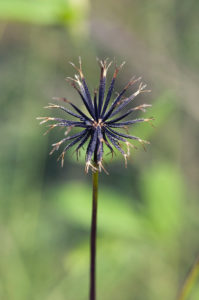
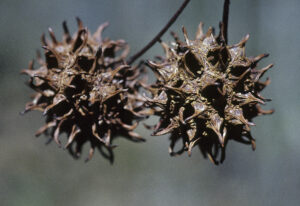

The term is derived from Middle English burre, adapted from the Norse burre, the name of burdock (see Asteraceae below).
The generic name is derived from the Latin liquidus (‘liquid’) and the Arabic anbar, which, via the Moors, became ambar in Spanish. Amber from members of this genus was formerly used in the cosmetic industry.
Formerly, these trees were placed in the witch-hazel family (Hamamelidaceae), but have since been transferred to Altingiaceae.
It is mainly found in warmer temperate climates, growing in forests as well as in open areas. It is native to central and southern China, Taiwan, and Indochina, but is commonly planted elsewhere as an ornamental tree.
Chinese sweetgum is often used in traditional medicine, the bark for skin diseases, the resin for boils, toothache and tuberculosis, and the fruits for a number of ailments, including arthritis, lumbago, and skin diseases. It seems that leaves and roots can inhibit growth of cancer.
The specific name is from the Portuguese formosa (‘beautiful’), a word that they applied to Taiwan, when they occupied the island. Most species, which bear variants of this name, were described from material stemming from Taiwan.
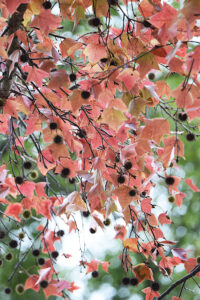

The leaves are almost star-shaped, with 5 to 7 pointed lobes.
The specific name is derived from Ancient Greek styrax, the name of the tree Styrax officinalis and its fragrant balsam, and from the Latin fluere (‘to flow’), thus ‘flowing with fragrant gum’.

In North America and Australia, it has invaded open grasslands, meadows, roadsides, abandoned fields, waste areas, and degraded prairies, often displacing native plants. In his delightful book All about Weeds, American botanist Edwin Spencer (1881-1964) says: “(…) authorities say that it is the cultivated carrot run wild. If it is, it has run a long way and into all sorts of places. It seems never to be the least particular in its choice of a habitat. It thrives in uncultivated ground, wherever or whatever it may be, as long as it is not densely shaded.”
The generic name is derived from the Ancient Greek daukos, a term first applied by Greek-Roman physician, surgeon, and philosopher Aelius Galenus (c. 129-210 A.D.), also known as Claudius Galenus or Galen of Pergamon, to distinguish the carrot from the parsnip. The specific name, derived from the Greek karoton (‘carrot’), first appears in the writings of Greek rhetorician and grammarian Athenaeus of Naucratis (c. 170-220 A.D.). The English name evolved around 1530, derived from Middle French carotte.
The popular name bird’s-nest refers to the umbel, which, after flowering, curls upwards, forming a dense structure, which somewhat resembles a bird’s nest. The popular names bishop’s lace and Queen Anne’s lace were given in allusion to the inflorescence, which resembles lace. The Anne in question may refer to Queen Anne of Great Britain (1665-1714), or to her great grandmother, Anne of Denmark (1574-1619), who was married to King James Charles Stuart (1566-1625). In those days, lace was prominent in fine clothing.
The species is described in depth on the page Plants: Plants in folklore and poetry.

The genus was named in honour of Russian statesman Alexander Turgenev (1784-1845), Director of the Department of the General Directorate of Religious Affairs of Foreign Faiths, appointed by Prince Dmitry Vladimirovich Golitsyn (1771-1844).
It grows in waste places and ditches, and along roads, found from central Europe eastwards to European Russia and Xinjiang, southwards to northern Africa, Iran, and Pakistan.
The specific name is Latin, meaning ‘with broad leaves’.
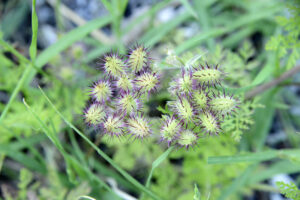
The stem is divided into several branches, and at the end of these are many flowerheads with lovely, reddish-violet flowers, which attract numerous hoverflies, bumblebees, and butterflies. Each of the flowerheads is surrounded by an armour of hooked spines. When the seeds are ripe, the entire flowerhead is easily detached, for instance when the pelt of a fox or a woollen sweater brushes against the hooks.
Even when the plant is flowering, these hooks are nasty, and woe the small bird or bat whose wing gets stuck on the hooks. They will face a slow death, unless a predator passes by.
In his delightful book All about Weeds, American botanist Edwin Spencer (1881-1964) writes about the burs: “Sometimes (a boy) is mean enough to throw a bunch of the burs into the hair of a rival, or even into the hair of the girl he thinks has snubbed him. She who has had this experience needs no technical description of the burdock.”
The generic name is derived from the Greek arktos (‘bear’), in allusion to the burs, which are somewhat similar to bear claws. Of course, the name burdock also refers to the burs, dock being a term applied to various plants with large leaves. And burdock leaves are large, growing up to 70 cm long and almost as wide.
One authority states that the specific name stems from the Celtic word llap (‘hand’), alluding to the ‘gripping’ burs. The popular name herrif is derived from two Anglo-Saxon words, haeg (‘hedge’), and reafe (‘robber’), perhaps referring to the vigorous growth of this species. Other folk names include fox’s clote, thorny bur, clot-bur, beggar’s buttons, and cockle buttons.
The role of great burdock in folklore, poetry, and medicine is described on the page Plants: Plants in folklore and poetry.

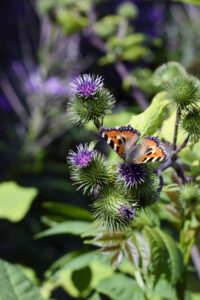
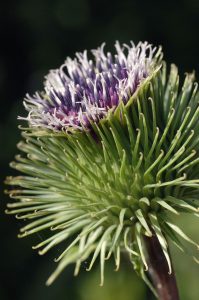
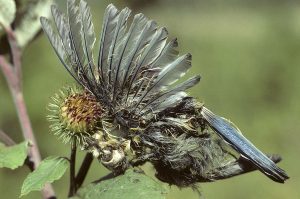


The generic name is from the Latin bi (’two’) and dens (’tooth’), alluding to the mostly 2 (sometimes 3 or 4) sharp, hooked teeth on the seeds, which easily get attached to animals’ pelts or people’s clothes, hereby often being spread a considerable distance from the mother plant. This way of seed dispersal has given rise to names like beggar-ticks, stickseed, farmer’s friend (sic!), needle grass, Spanish needles, stick-tight, cobbler’s pegs, Devil’s needles, and Devil’s pitchfork.
In the 1700s, sheep were fed with bur-marigold to protect them from disease and intestinal worms.
It was formerly used as a remedy for bleeding, kidney problems, and ulcers. Young leaves are edible when cooked.
The specific name refers to the tripartite leaves.
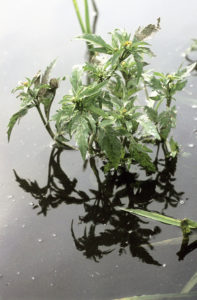
The specific name is Latin, meaning ‘nodding’.
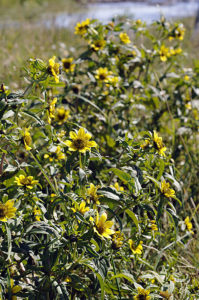
A South African website, farmersweekly.co.za/animals/horses/beware-those-blackjacks, says: “The common blackjack is not only an irritant to horses, (but) can cause them injury. (…) There can be few of us who have not spent ages picking them off our clothes after walking through the veld to catch horses in the early winter. Blackjacks that become entangled in the forelock of a horse can be a great irritant, and the animal will toss its head, if you try to remove them. The spines can injure the eyes, so it’s better to clip the forelocks short. Blackjacks can also get caught up in the long hair behind the fetlocks and pasterns, causing chronic irritation and lameness.”
This species is reported to be a weed of 31 crops in more than 40 countries, Latin America and eastern Africa having the worst infestations. (Source: cabi.org/isc/datasheet/9148)
However, downy bur-marigold is not only a troublesome weed, it also has medicinal properties. In traditional Chinese medicine, it has been used for a large number of ailments, including influenza, colds, fever, sore throat, appendicitis, hepatitis, malaria, and haemorrhoids. Due to its high content of fiber, it is beneficial to the cardiovascular system, and it has been used with success in treatment of diabetes.
The specific name is Latin, meaning ‘hairy’.

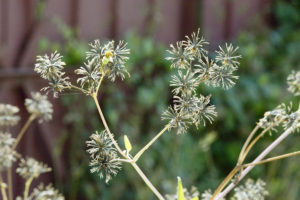
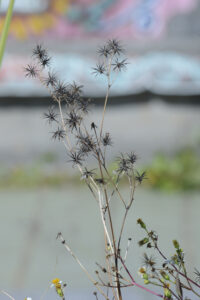
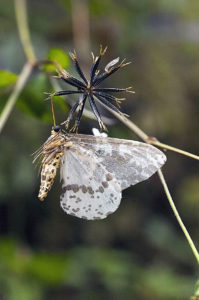
The generic name is derived from xanthion, the Greek name of rough cocklebur (below), derived from xanthos (‘yellow’). The juice of this plant was formerly utilized to dye the hair yellow. The prefix cockle is unexplained.
In his delightful book All about Weeds, American botanist Edwin Spencer (1881-1964) writes about the cocklebur: “They are very likely to find lodgment in upland fields. The hooks on the bur of the cocklebur are a clever device for seed distribution. Every animal that walks through a patch of cockleburs or even brushes against a single plant, when its seeds are ripe, gives a free ride to as many burry passengers as come in contact with the hair or clothing of that unsuspecting animal. Every hunter and his dog help this culprit over the fences into other fields.”
The Zuni people of south-western United States used this plant for many purposes. The seeds were ground, mixed with cornmeal and made into cakes, which were then steamed. When performing a cactus ceremony, they rubbed chewed seeds onto the body to protect it from the spines. A poultice, containing cocklebur seeds, was applied to wounds or used to remove splinters. (Source: M.C. Stevenson 1915. Ethnobotany of the Zuni Indians. SI-BAE Annual Report No. 30)
The specific name indicates that the plant was formerly used for treatment of struma.
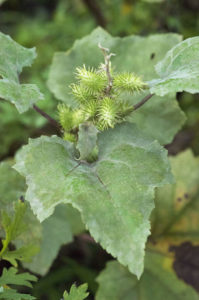

The generic name is Latin for ‘tick’, referring to the seed, which resembles certain species of ticks. The specific name means ‘common’. The name castor oil plant was given in allusion to the former usage of the seed oil as a powerful laxative, whereas another popular name, Palm of Christ, refers to the similarity between Christ and this plant: As the belief in Christ can help psychological problems, Ricinus oil is able to cure a variety of physical ailments.
The medicinal usage of the castor oil plant is described on the page Plants: Plants in folklore and poetry.
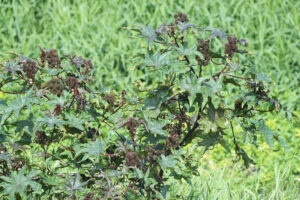

Sweet chestnut is widely cultivated for its edible nuts and for its wood. Raw chestnuts are covered by a tough skin, which has an unpleasant, astringent taste. They are usually roasted, which makes it easier to remove the skin. Chestnut orchards are commonly found in Spain, Portugal, France, Switzerland, Italy, Greece, and elsewhere.
During my stay in the Zagros Mountains in south-western Iran (see Travel episodes – Iran 1973: In the mountains of Luristan), I was told that fruits of sweet chestnut, which is common in these mountains, were an important food item, when the wheat crop failed.
In his book Flora Danica, from 1648, Danish physician and herbalist Simon Paulli (1603-1680) says: ”Galenus [Claudius Galenus (130-210 A.D.), Greek-Roman physician and philosopher] praises the fruits of sweet chestnut above all other kinds of acorns, which are good to eat. We must point out that we do not agree with Johan Bodæo à Stapel, who, with beautiful and learned comments, has illustrated Theophrastum Eresium [a work by Greek scholar and botanist Theophrastos (c. 371 – c. 287 B.C.), called ‘The Father of Botany’]; because he claims that sweet chestnuts are a kind of nuts. However, to us it seems more appropriate to regard them as a kind of acorns, but we do not want to go into detail here. (…)
Those, who hold their health in high esteem, should take care that they do not eat too many sweet chestnuts, because the above-mentioned Galenus also says this about them: (…) Sweet chestnuts, cooked or fried or dried over a fire, are always evil, but above all when they are eaten raw.”
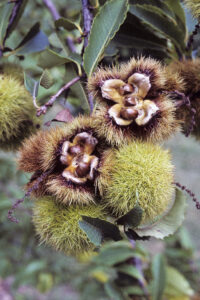
The generic name refers to Circe, in Ancient Greek Kirke, a mythical sorceress, who had a vast knowledge of magic potions and herbs. Using these, and a magic wand, she was able to transform her enemies to beasts. Efter poisoning her husband, she settled on the island of Aiaia. When Odysseus landed on her island on his way back from Troy, she transformed his men into swine, but, with the help of the god Hermes, he forced her to end the spell.
The name of the sorceress is derived from the verb kirkoô (‘to secure with rings’), alluding to the binding power of magic. Supposedly, she used plants of this genus in her spells, reflected in the English name. These plants are not especially toxic, but contain much tannin, which is astringent.
The stem grows to 60 cm tall, rarely to 75 cm. The leaves are heart-shaped, long-pointed, toothed, with indented nerves. The white flowers have 2 petals, 2 stamens, and a white or pinkish stigma. The fruit is a small ovoid bur, 3-5 mm long.
The specific name is derived from Lutetia, the Latin name for Paris, which, in the old days, was sometimes referred to as the Witch City.
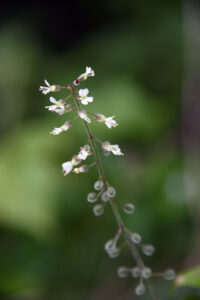
These plants are very important in traditional medicine, and extracts from the tubers are taken for pain and as an anti-inflammatory. They are protected, and collecting may only take place with a permit from the departments of nature conservation.
The generic name is derived from Ancient Greek harpage (‘hook’) and phyton (‘plant’), alluding to the hooks on the fruit, which will stick to an animal or person treading on it. The nastiness of these hooks is reflected in the common name.
The specific name is Latin, meaning ‘prostrate’, alluding to the creeping habit of this plant.
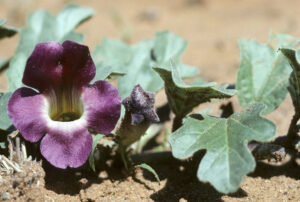

The fruits are very distinctive, ball-shaped, to 4 cm across, consisting of numerous small nut-like achenes, each ending in a spike. They are arranged in pendent clusters, up to 12 together.
The generic name is a Latinized version of Ancient Greek platanos, which was the name of maple trees (Acer). It refers to the maple-like leaves of the oriental plane tree (below). Some North American species are called sycamores, likewise referring to the leaves, which resemble those of the European sycamore maple (Acer pseudoplatanus).
It is distributed from the Balkans and Turkey southwards to Jordan, but may be a native as far west as Italy, and as far east as Kashmir, where it is very commonly planted up to an elevation of about 2,400 m.
The bark is used medicinally.
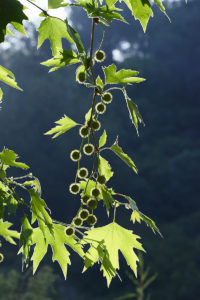
In his delightful book All about Weeds, American botanist Edwin Spencer (1881-1964) writes about an American species, C. tribuloides: “Most people know only the bur (of this species), which is one of the sharpest of armed fruits. It sticks to the clothing and pierces the fingers when one attempts to remove it. No other grassy plant has this fruit, this lance-armed bur, and a description therefore is almost useless. He who finds a sandbur does not have to be told what it is.”
This species is native to tropical America, but has become naturalized in most tropical and subtropical areas, easily spreading by its spiny fruits, which attach themselves to almost anything. It grows in many different habitats and is regarded as an agricultural weed in 35 countries.
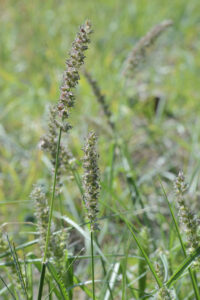
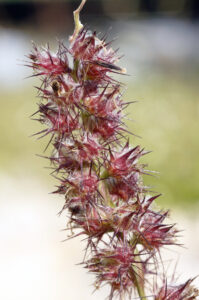
The specific name was given in honour of King Mithridates VI of Pontus (134-63 B.C.), called Eupator Dionysius (which can be translated as ‘the noble father of plants’), who was a renowned herbalist.
A common name of the plant, church steeples, refers to its long, spire-like inflorescence, whereas cocklebur and sticklewort alludes to the prickly fruits, which easily detach when in contact with socks, sweaters, animal furs, etc.
Roman naturalist Pliny the Elder (23-79 A.D.) calls agrimony an “herb of princely authority,” whereas Greek physician, pharmacologist, and botanist Pedanius Dioscorides (died 90 A.D.), who was the author of De Materia Medica (five volumes dealing with herbal medicine), states that it is not only “a remedy for those that have bad livers,” but also “for such as are bitten by serpents.”
English herbalist John Gerard (c. 1545-1612) says: “A decoction of the leaves is good for them that have naughty livers,” whereas another herbalist, Nicholas Culpeper (1616-1654), recommends it, in addition to the uses above, for gout, “either used outwardly in an oil or ointment, or inwardly, in an electuary or syrup, or concreted juice.” He praises its use externally, stating how sores may be cured “by bathing and fomenting them with a decoction of this plant,” and that it heals “all inward wounds, bruises, hurts and other distempers.” He continues: “The decoction of the herb, made with wine and drunk, is good against the biting and stinging of serpents . . . it also helpeth the colic, cleanseth the breath and relieves the cough. A draught of the decoction taken warm before the fit first relieves and in time removes the tertian and quartian ague.” [Ague is an old term for malaria.] And furthermore: “Agrimony draweth forth thorns, splinters of wood, or any such thing in the flesh. It helpeth to strengthen members that are out of joint.”
In his compendium The Vegetable System, English botanist John Hill (c. 1714-1775) recommends “an infusion of 6 oz. of the crown of the root in a quart of boiling water, sweetened with honey and half a pint drank three times a day,” for jaundice.
The role of this plant in folklore is described on the page Plants: Plants in folklore and poetry.
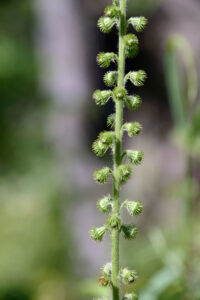

At maturity, the fruits of some species are hooked at the apex, an adaptation to seed dispersal. In other species, a silky tuft of brownish hairs grows from the styles, which has given rise to a popular German name of these plants, Petersbart (‘Peter’s beard’), probably referring to St. Peter.
The generic name is derived from Ancient Greek geno (‘yielding a pleasant aroma’), referring to the clove-like smell of the root, when it has just been dug up. The English name is derived from the Latin avencia, supposedly alluding to of a kind of clover. However, with reference to the generic name, it seems more reasonable to connect it with cloves instead of clover, so maybe someone made a mistake in explaining the name!
The specific name is Latin, meaning ‘living in cities’ – a strange name for this plant, which mainly grows in forests, although it may occasionally be found as a weed in city gardens.
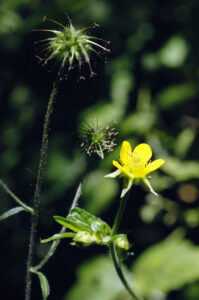
The generic name is derived from the Greek gala (’milk’), alluding to the usage of yellow bedstraw (G. verum) in rennet, as its flowers are able to coagulate milk to make cheese. In his book Herbal Simples, Dr. William T. Fernie (1830-1914) writes: “The people in Cheshire, especially about Nantwich, where the best cheese is made, do use it [yellow bedstraw] in their rennet, esteeming greatly of that cheese above other made without it.”
In his delightful book All about Weeds, American botanist Edwin Spencer (1881-1964) has the following comment about this plant: “When one walks into some loose, trailing weeds, and they all seem glad to be torn from their roots in order to ride away clinging to his trousers, he has made contact with (…) either Galium aparine or Galium asprillum. These are the two (species of bedstraw) with the rough stems – the two that have this unique way of scattering their seeds. For of course those straws cling to the sheep’s wool and the dog’s hair just as they do to clothing, and sometimes they and their seeds are carried a long way by animals.”
The common name derives from ‘to cleave’, meaning ‘to stick to’, of course alluding to the stems and seeds sticking to passing animals or persons. It is also known by other names with the same meaning, including catchweed, sticky bob, and sticky willy, whereas robin-run-the-hedge refers to its scrambling habit.
It is native to the major part of Europe, North Africa, and temperate areas of Asia, eastwards to Japan. It may also be indigenous in North America, and it has also become naturalized in Mexico, Central America, South America, Australia, New Zealand, and parts of Africa.
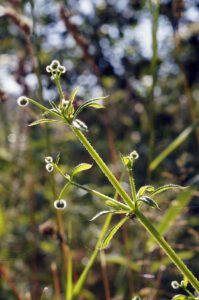
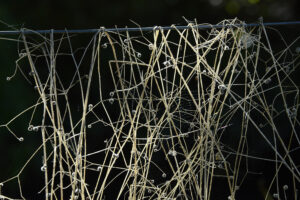
Fruits of these plants have 2-4 very strong spines, which have given rise to the generic name, from the Greek tribolos, meaning caltrop, a small metal object with several spikes, of which one is always pointing upwards. In the old days, these weapons were spread on roads and footpaths to prevent traffic of the enemy’s soldiers, horse riders, and horse-drawn vehicles.
When the fruit is lying on the ground, at least one thorn is always pointing upwards, so that it may stick to a foot of a passing animal. If a furry animal, like a sheep, lies down in an area with these fruits, several of them will stick to its fleece. In this way, the seeds may be widely dispersed. Much damage has been done to the feet of livestock by these fruits.
A prostrate herb, very variable, branches to 60 cm long, spreading, leaves opposite, pinnately divided, to 5 cm long. The flowers are yellow (sometimes white with yellow centre), to 1.5 cm across. The fruit is to 1 cm across, with 2 long and 2 short, very strong spines, which are able to penetrate a bicycle tyre, giving rise to the popular name puncture vine.
This plant is very widely distributed, from southern Europe eastwards across Central Asia to Japan, southwards to southern Africa, Sri Lanka, and Indochina. It is used medicinally.
